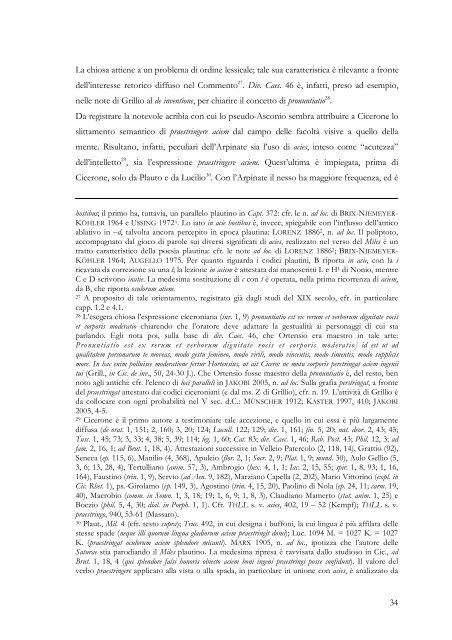3Eterov e)ce(te/rou sofo\v to/ te pa/lai to/ te nu=n. Ou ... - EleA@UniSA
3Eterov e)ce(te/rou sofo\v to/ te pa/lai to/ te nu=n. Ou ... - EleA@UniSA
3Eterov e)ce(te/rou sofo\v to/ te pa/lai to/ te nu=n. Ou ... - EleA@UniSA
Create successful ePaper yourself
Turn your PDF publications into a flip-book with our unique Google optimized e-Paper software.
La chiosa attiene a un problema di ordine lessicale; tale sua carat<strong>te</strong>ristica è rilevan<strong>te</strong> a fron<strong>te</strong><br />
dell’in<strong>te</strong>resse re<strong>to</strong>rico diffuso nel Commen<strong>to</strong> 27 . Div. Caec. 46 è, infatti, preso ad esempio,<br />
nelle no<strong>te</strong> di Grillio al de inventione, per chiarire il con<strong>ce</strong>t<strong>to</strong> di pronuntiatio 28 .<br />
Da registrare la no<strong>te</strong>vole acribia con cui lo pseudo-Asconio sembra attribuire a Ci<strong>ce</strong>rone lo<br />
slittamen<strong>to</strong> semantico di praestringere aciem dal campo delle facoltà visive a quello della<br />
men<strong>te</strong>. Risultano, infatti, peculiari dell’Arpina<strong>te</strong> sia l’uso di acies, in<strong>te</strong>so come “acu<strong>te</strong>zza”<br />
dell’in<strong>te</strong>llet<strong>to</strong> 29 , sia l’espressione praestringere aciem. Quest’ultima è impiegata, prima di<br />
Ci<strong>ce</strong>rone, solo da Plau<strong>to</strong> e da Lucilio 30 . Con l’Arpina<strong>te</strong> il nesso ha maggiore frequenza, ed è<br />
hostibus; il primo ha, tuttavia, un <strong>pa</strong>rallelo plautino in Capt. 372: cfr. le n. ad loc. di BRIX-NIEMEYER-<br />
KÖHLER 1964 e USSING 1972 A. Lo ia<strong>to</strong> in acie hostibus è, inve<strong>ce</strong>, spiegabile con l’influsso dell’antico<br />
ablativo in –d, talvolta ancora per<strong>ce</strong>pi<strong>to</strong> in epoca plautina: LORENZ 1886 2, n. ad loc. Il polip<strong>to</strong><strong>to</strong>,<br />
accom<strong>pa</strong>gna<strong>to</strong> dal gioco di <strong>pa</strong>role sui diversi significati di acies, realizza<strong>to</strong> nel verso del Miles è un<br />
trat<strong>to</strong> carat<strong>te</strong>ristico della poesia plautina: cfr. le no<strong>te</strong> ad loc. di LORENZ 1886 2; BRIX-NIEMEYER-<br />
KÖHLER 1964; AUGELLO 1975. Per quan<strong>to</strong> riguarda i codici plautini, B riporta in acie, con la i<br />
ricavata da correzione su una l; la lezione in aciem è at<strong>te</strong>stata dai manoscritti L e H 1 di Nonio, mentre<br />
C e D scrivono inatie. La medesima sostituzione di c con t è operata, nella prima ricorrenza di aciem,<br />
da B, che riporta oculorum atiem.<br />
27 A proposi<strong>to</strong> di tale orientamen<strong>to</strong>, registra<strong>to</strong> già dagli studi del XIX secolo, cfr. in <strong>pa</strong>rticolare<br />
capp. 1.2 e 4.1.<br />
28 L’esegeta chiosa l’espressione ci<strong>ce</strong>roniana (inv. 1, 9) pronuntiatio est ex rerum et verborum dignita<strong>te</strong> vocis<br />
et corporis moderatio chiarendo che l’ora<strong>to</strong>re deve adattare la gestualità ai personaggi di cui sta<br />
<strong>pa</strong>rlando. Egli nota poi, sulla base di div. Caec. 46, che Or<strong>te</strong>nsio era maestro in tale ar<strong>te</strong>:<br />
Pronuntiatio est ex rerum et verborum dignita<strong>te</strong> vocis et corporis moderatio] id est ut ad<br />
qualita<strong>te</strong>m personarum <strong>te</strong> moveas, modo gestu femineo, modo virili, modo vin<strong>ce</strong>ntis, modo timentis, modo supplicis<br />
more. In hac enim polluisse moderatione fertur Hor<strong>te</strong>nsius, ut ait Ci<strong>ce</strong>ro: ne motu corporis perstringat aciem ingenii<br />
tui (Grill., in Cic. de inv., 50, 24-30 J.). Che Or<strong>te</strong>nsio fosse maestro della pronuntiatio è, del res<strong>to</strong>, ben<br />
no<strong>to</strong> agli antichi: cfr. l’elenco di loci <strong>pa</strong>ralleli in JAKOBI 2005, n. ad loc. Sulla grafia perstringat, a fron<strong>te</strong><br />
del praestringat at<strong>te</strong>sta<strong>to</strong> dai codici ci<strong>ce</strong>roniani (e dal ms. Z di Grillio), cfr. n. 19. L’attività di Grillio è<br />
da collocare con ogni probabilità nel V sec. d.C.: MÜNSCHER 1912; KASTER 1997, 410; JAKOBI<br />
2005, 4-5.<br />
29 Ci<strong>ce</strong>rone è il primo au<strong>to</strong>re a <strong>te</strong>stimoniare tale ac<strong>ce</strong>zione, e quello in cui essa è più largamen<strong>te</strong><br />
diffusa (de orat. 1, 151; 2, 160; 3, 20; 124; Lucull. 122; 129; div. 1, 161; fin. 5, 20; nat. deor. 2, 43; 45;<br />
Tusc. 1, 45; 73; 3, 33; 4, 38; 5, 39; 114; leg. 1, 60; Cat. 83; div. Caec. 1, 46; Rab. Post. 43; Phil. 12, 3; ad<br />
fam. 2, 16, 1; ad Brut. 1, 18, 4). At<strong>te</strong>stazioni suc<strong>ce</strong>ssive in Velleio Pa<strong>te</strong>rcolo (2, 118, 14), Grattio (92),<br />
Seneca (ep. 115, 6), Manilio (4, 368), Apuleio (flor. 2, 1; Socr. 2, 9; Plat. 1, 9; mund. 30), Aulo Gellio (5,<br />
3, 6; 13, 28, 4), Tertulliano (anim. 57, 3), Ambrogio (hex. 4, 1, 1; Iac. 2, 15, 55; spir. 1, 8, 93; 1, 16,<br />
164), Faustino (trin. 1, 9), Servio (ad Aen. 9, 182), Marziano Capella (2, 202), Mario Vit<strong>to</strong>rino (expl. in<br />
Cic. Rhet. 1), ps.-Girolamo (ep. 149, 3), Agostino (trin. 4, 15, 20), Paolino di Nola (ep. 24, 11; carm. 19,<br />
40), Macrobio (comm. in Somn. 1, 3, 18; 19; 1, 6, 9; 1, 8, 3), Claudiano Mamer<strong>to</strong> (stat. anim. 1, 25) e<br />
Boezio (phil. 5, 4, 30; dial. in Porph. 1, 1). Cfr. THLL s. v. acies, 402, 19 – 52 (Kempf); THLL s. v.<br />
praestringo, 940, 53-61 (Massaro).<br />
30 Plaut., Mil. 4 (cfr. <strong>te</strong>s<strong>to</strong> supra); Truc. 492, in cui designa i buffoni, la cui lingua è più affilata delle<br />
s<strong>te</strong>sse s<strong>pa</strong>de (neque illi quorum lingua gladiorum aciem praestringit domi); Luc. 1094 M. = 1027 K. = 1027<br />
K. (praestringat oculorum aciem splendore micanti). MARX 1905, n. ad loc., ipotizza che l’au<strong>to</strong>re delle<br />
Saturae stia <strong>pa</strong>rodiando il Miles plautino. La medesima ripresa è ravvisata dallo studioso in Cic., ad<br />
Brut. 1, 18, 4 (qui splendore falsi honoris obiec<strong>to</strong> aciem boni ingeni praestringi posse confidunt). Il valore del<br />
verbo praestringere applica<strong>to</strong> alla vista o alla s<strong>pa</strong>da, in <strong>pa</strong>rticolare in unione con acies, è analizza<strong>to</strong> da<br />
34
















